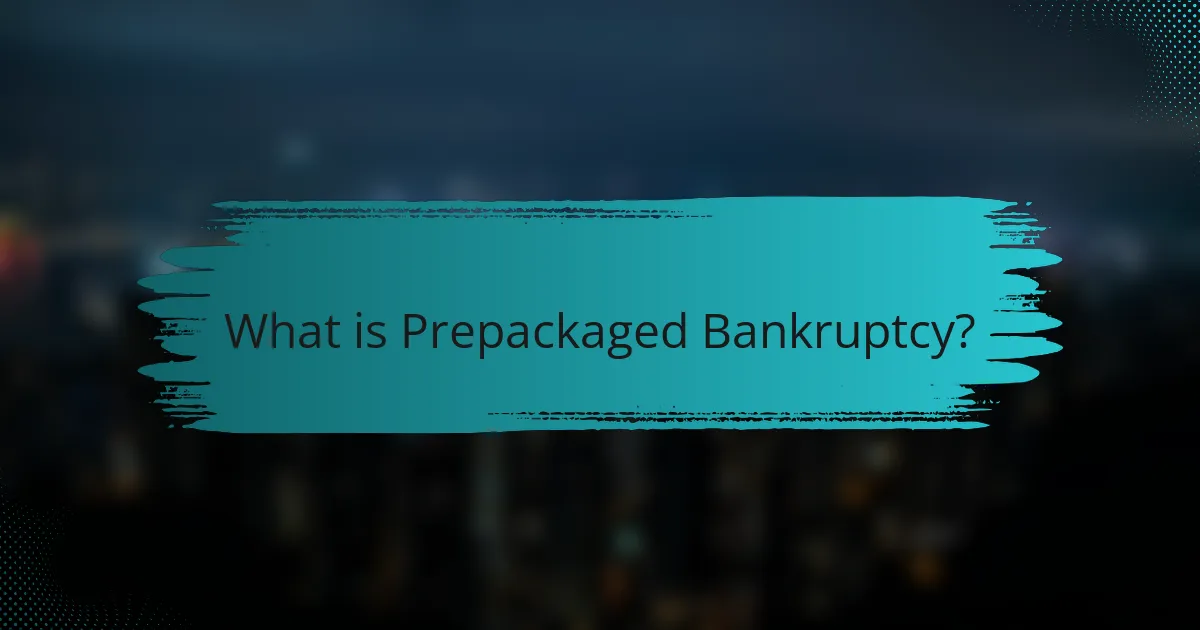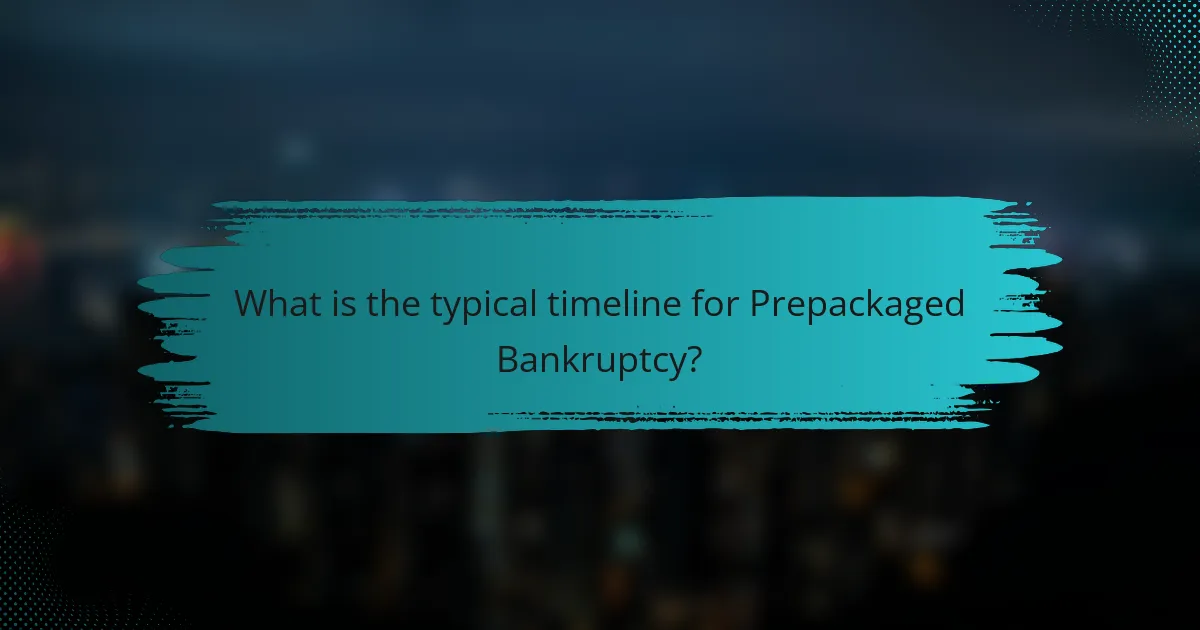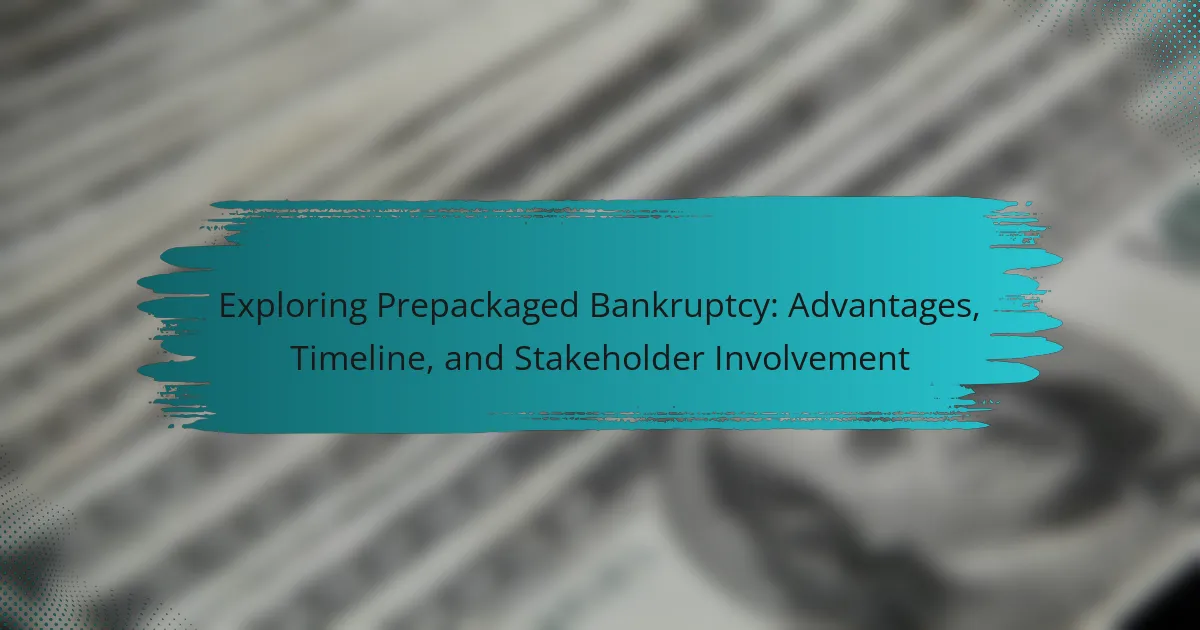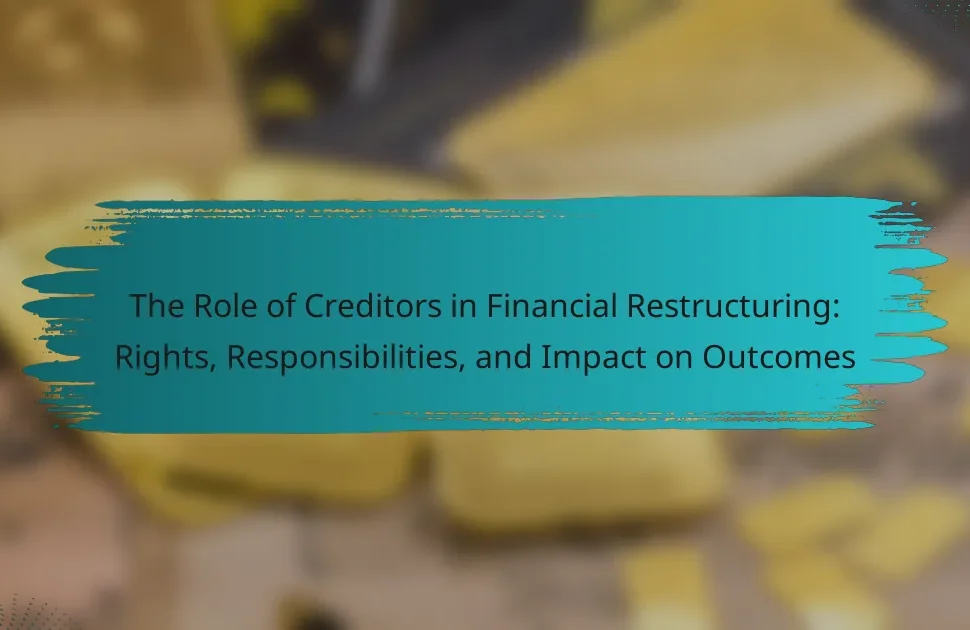Prepackaged bankruptcy is a structured approach where a company negotiates a restructuring plan with its creditors prior to filing for bankruptcy, allowing for expedited approval and implementation. This process typically spans 3 to 6 months and involves key stakeholders, including creditors, shareholders, and legal and financial advisors, each playing vital roles in shaping the outcome. The article explores the advantages of prepackaged bankruptcy, such as reduced costs and minimized business disruption, as well as the typical timeline and the responsibilities of involved parties. By providing a clear understanding of this bankruptcy method, the article highlights its potential for facilitating a successful corporate turnaround.

What is Prepackaged Bankruptcy?
Prepackaged bankruptcy is a form of bankruptcy where a company negotiates a restructuring plan with creditors before filing for bankruptcy. This approach allows the company to obtain creditor approval for its plan in advance. The prepackaged plan is then submitted to the bankruptcy court during the filing process. This method can expedite the bankruptcy process compared to traditional bankruptcy. It typically results in a quicker resolution and less disruption to the business. Companies often choose this route to minimize costs and maintain operations. Prepackaged bankruptcy can also enhance the likelihood of a successful turnaround.
How does Prepackaged Bankruptcy differ from traditional bankruptcy?
Prepackaged bankruptcy differs from traditional bankruptcy primarily in its approach to restructuring debt. In prepackaged bankruptcy, a company negotiates a restructuring plan with creditors before filing for bankruptcy. This allows for a faster process and less disruption to operations. Traditional bankruptcy, on the other hand, often involves lengthy court proceedings without prior agreements in place. In prepackaged cases, the plan is usually confirmed quickly, often within a few months. This efficiency can save costs and preserve value for stakeholders. Traditional bankruptcy may take years to resolve, leading to greater uncertainty and potential loss of assets.
What are the key features of Prepackaged Bankruptcy?
Prepackaged bankruptcy involves a plan for restructuring debts agreed upon before filing for bankruptcy. This process allows companies to negotiate with creditors and gain their approval in advance. Key features include a streamlined process that typically reduces court time, as the plan is already established. It often results in a quicker exit from bankruptcy, benefiting both the debtor and creditors. The plan must be approved by a majority of creditors before filing. This type of bankruptcy minimizes disruptions to business operations. It can also preserve company value better than traditional bankruptcy methods. Overall, prepackaged bankruptcy is designed to facilitate a more efficient resolution of financial distress.
Why might a company choose Prepackaged Bankruptcy over other options?
A company might choose Prepackaged Bankruptcy for its efficiency and speed. This option allows for a quicker resolution compared to traditional bankruptcy processes. Companies can negotiate a plan with creditors before filing. This pre-arrangement often leads to fewer disruptions in operations. Additionally, it can reduce legal costs significantly. By having creditor support beforehand, companies can present a viable plan to the court. This approach minimizes uncertainty for stakeholders. It also helps maintain customer and employee confidence during the restructuring process.
What are the advantages of Prepackaged Bankruptcy?
Prepackaged bankruptcy offers several advantages for distressed companies. It allows for a faster restructuring process compared to traditional bankruptcy. The prepackaged plan is agreed upon before filing, which minimizes court time. This approach can lead to reduced legal fees and administrative costs. Stakeholders often have more certainty about the outcome, enhancing cooperation. Additionally, it can preserve the company’s value and facilitate a smoother transition post-bankruptcy. Research indicates that companies utilizing prepackaged bankruptcy often exit with a stronger financial position.
How does Prepackaged Bankruptcy expedite the restructuring process?
Prepackaged Bankruptcy expedites the restructuring process by allowing companies to negotiate a plan with creditors before filing. This advance agreement reduces the time spent in court. It typically leads to a faster confirmation of the bankruptcy plan. The process often shortens the overall duration of bankruptcy proceedings. According to the American Bankruptcy Institute, prepackaged cases can be resolved in as little as 30 to 90 days. This efficiency minimizes disruption to business operations. Additionally, it can lower legal costs associated with lengthy bankruptcy processes. Overall, prepackaged Bankruptcy streamlines negotiations and court approvals, facilitating quicker financial recovery.
What financial benefits can be gained from Prepackaged Bankruptcy?
Prepackaged bankruptcy offers several financial benefits. It allows companies to restructure debt efficiently while avoiding lengthy court proceedings. This process can significantly reduce legal costs, often estimated to be lower than traditional bankruptcies. Additionally, it enables companies to negotiate terms with creditors before filing, leading to more favorable repayment plans. Prepackaged bankruptcy can also preserve business operations and employee jobs, which maintains revenue streams. According to a study by the American Bankruptcy Institute, companies that undergo prepackaged bankruptcy often emerge more financially stable. This stability can enhance investor confidence and potentially improve stock performance post-restructuring.

What is the typical timeline for Prepackaged Bankruptcy?
The typical timeline for prepackaged bankruptcy is approximately 3 to 6 months. This process begins with negotiations between the debtor and creditors to finalize a restructuring plan. Once an agreement is reached, the debtor files the bankruptcy petition along with the prepackaged plan. The court then schedules a confirmation hearing. This hearing usually occurs within a few weeks of filing. If the court approves the plan, the restructuring can be implemented quickly. This expedited timeline is one of the key advantages of prepackaged bankruptcy compared to traditional bankruptcy processes, which can take significantly longer.
How long does the Prepackaged Bankruptcy process usually take?
The Prepackaged Bankruptcy process usually takes between three to six months. This duration is significantly shorter than traditional bankruptcy proceedings. The efficiency is due to pre-negotiated agreements with creditors. These agreements are finalized before filing for bankruptcy. This preparation allows for a quicker resolution. Additionally, court approval is often expedited. Overall, the streamlined nature of the process benefits all parties involved.
What are the stages involved in the Prepackaged Bankruptcy timeline?
The stages involved in the Prepackaged Bankruptcy timeline include preparation, filing, confirmation, and implementation. During preparation, the debtor negotiates a plan with creditors before filing. The filing stage involves submitting the bankruptcy petition and the prepackaged plan to the court. Next, the confirmation stage requires the court to approve the plan, ensuring it meets legal standards. Finally, implementation occurs when the debtor executes the plan and begins operations under the new terms. These stages streamline the bankruptcy process, allowing for quicker resolutions compared to traditional bankruptcy.
How can companies prepare to streamline the Prepackaged Bankruptcy timeline?
Companies can prepare to streamline the Prepackaged Bankruptcy timeline by developing a comprehensive plan early in the process. This includes engaging stakeholders to gather support and input. Clear communication with creditors can facilitate smoother negotiations. Additionally, companies should ensure that financial disclosures are accurate and timely. Having a solid restructuring plan ready can expedite court approval. Utilizing experienced legal counsel can help navigate complexities efficiently. Research indicates that well-prepared companies can reduce the duration of bankruptcy proceedings significantly. For example, a study by the American Bankruptcy Institute found that prepackaged bankruptcies can be resolved in as little as 30 to 60 days when properly managed.
What factors can affect the timeline of Prepackaged Bankruptcy?
The timeline of Prepackaged Bankruptcy can be affected by several factors. The complexity of the company’s financial situation plays a significant role. More complex cases require additional time for negotiations and approvals. The level of stakeholder agreement also impacts the timeline. If stakeholders are divided, the process may be prolonged. The efficiency of legal representation is crucial. Experienced attorneys can expedite the process through effective planning. Regulatory requirements can also introduce delays. Compliance with legal standards is necessary for timely approval. Lastly, market conditions can influence the timeline. Economic uncertainties may lead to extended negotiations. Each of these factors contributes to the overall duration of Prepackaged Bankruptcy proceedings.
How do negotiations with creditors impact the timeline?
Negotiations with creditors can significantly extend the timeline of prepackaged bankruptcy. These discussions often involve complex terms and conditions that require careful consideration. The process may take weeks or even months to finalize agreements. Delays can occur if creditors demand changes to proposals or additional concessions. Each negotiation round can prolong the overall timeline, affecting the debtor’s ability to emerge from bankruptcy quickly. According to research by the American Bankruptcy Institute, extended negotiations can lead to a longer restructuring process, impacting financial stability. Therefore, effective and timely negotiations are crucial for minimizing delays in the bankruptcy timeline.
What role does court approval play in the timeline of Prepackaged Bankruptcy?
Court approval is essential in the timeline of Prepackaged Bankruptcy. It validates the prepackaged plan agreed upon by creditors before filing. The approval process typically occurs shortly after the bankruptcy petition is filed. This expedited court approval can significantly shorten the overall bankruptcy timeline. Courts assess whether the plan meets legal requirements and is fair to all parties involved. Successful approval allows the debtor to emerge from bankruptcy more quickly. This efficiency is a primary reason entities choose prepackaged bankruptcy. Thus, court approval plays a critical role in facilitating a swift resolution for distressed companies.

Who are the key stakeholders involved in Prepackaged Bankruptcy?
The key stakeholders involved in prepackaged bankruptcy include creditors, shareholders, and the company itself. Creditors are typically the primary stakeholders, as they negotiate the terms of the prepackaged plan. Shareholders also play a crucial role, as their interests must be considered in the restructuring process. The company, or debtor, initiates the prepackaged bankruptcy to facilitate a quicker resolution. Legal advisors and financial advisors are also key stakeholders, providing necessary guidance throughout the process. Additionally, the bankruptcy court oversees the proceedings to ensure compliance with legal standards. Each of these stakeholders has distinct interests and responsibilities that influence the outcome of the prepackaged bankruptcy.
What roles do creditors play in the Prepackaged Bankruptcy process?
Creditors play a crucial role in the Prepackaged Bankruptcy process. They are involved in negotiating the terms of the prepackaged plan before the bankruptcy filing. Creditors must approve the plan for it to be effective. Their agreement is essential for the success of the restructuring process. Creditors also influence the treatment of their claims and the distribution of assets. They may receive new securities or equity in exchange for their debts. This negotiation often occurs under tight timelines to expedite the process. The involvement of creditors helps ensure that the plan addresses their interests effectively.
How do equity holders influence the outcome of Prepackaged Bankruptcy?
Equity holders influence the outcome of prepackaged bankruptcy by negotiating terms that affect the restructuring plan. They can sway the approval of the plan through their voting power. Equity holders often negotiate for a better recovery or retention of their ownership stake. Their involvement can lead to a more favorable outcome for the company’s future. In many cases, equity holders may need to agree to dilution or other sacrifices. This agreement can help secure creditor support for the plan. Additionally, their participation can enhance the perceived legitimacy of the restructuring efforts. Ultimately, equity holders play a crucial role in shaping the restructuring landscape during prepackaged bankruptcy.
What is the role of legal counsel in Prepackaged Bankruptcy?
Legal counsel plays a critical role in prepackaged bankruptcy. They advise companies on structuring the bankruptcy plan. Counsel ensures compliance with legal requirements throughout the process. They assist in negotiating with creditors to gain support for the plan. Legal experts also prepare necessary documents for court submission. Their role includes representing the company in hearings. Counsel helps navigate potential legal challenges during the process. Effective legal guidance can facilitate a smoother and quicker bankruptcy resolution.
How do stakeholders collaborate during Prepackaged Bankruptcy?
Stakeholders collaborate during Prepackaged Bankruptcy by negotiating and agreeing on a restructuring plan before filing. This collaboration involves creditors, equity holders, and the distressed company working together. They discuss terms such as debt reductions and equity exchanges. This process aims to reach consensus to facilitate a smoother bankruptcy process. Stakeholders often hold meetings to align their interests and expectations. Legal advisors typically assist in drafting the prepackaged plan. Once an agreement is reached, stakeholders vote on the plan. Approval from a majority is necessary to proceed with the bankruptcy filing. This cooperative approach helps minimize litigation and accelerates the bankruptcy timeline.
What strategies can stakeholders use to reach a consensus?
Stakeholders can use collaborative dialogue to reach a consensus. This involves open communication among all parties. Setting clear objectives helps align interests. Utilizing a neutral facilitator can guide discussions effectively. Stakeholders should actively listen to each other’s concerns. Creating a shared understanding fosters trust and cooperation. Engaging in compromise allows for flexible solutions. Documenting agreements ensures accountability and clarity. These strategies are supported by successful case studies in stakeholder negotiations.
How can effective communication among stakeholders improve outcomes?
Effective communication among stakeholders can significantly improve outcomes in prepackaged bankruptcy scenarios. Clear communication fosters alignment on goals and expectations. It ensures that all parties are informed of developments and changes in the process. This transparency reduces misunderstandings and conflicts. Stakeholders can provide timely feedback, facilitating quicker decision-making. Enhanced collaboration leads to more innovative solutions to financial challenges. Research shows that effective stakeholder engagement can increase the likelihood of successful restructuring outcomes. According to a study by the Harvard Business Review, companies with strong stakeholder communication report higher satisfaction and better performance post-bankruptcy.
What best practices should companies follow when engaging in Prepackaged Bankruptcy?
Companies should follow several best practices when engaging in Prepackaged Bankruptcy. First, they must ensure clear communication with stakeholders. Transparency helps build trust and manage expectations. Second, companies should conduct thorough financial analysis before filing. Understanding the financial position assists in crafting a viable plan. Third, they should engage experienced legal and financial advisors. Expertise is crucial for navigating complex bankruptcy laws. Fourth, companies need to develop a comprehensive restructuring plan. This plan should address operational and financial challenges. Fifth, obtaining creditor support is essential for a successful outcome. Engaging creditors early can facilitate smoother negotiations. Lastly, companies should prepare for a timely execution of the plan. A swift process minimizes disruption and costs. These practices enhance the likelihood of a successful prepackaged bankruptcy.
Prepackaged bankruptcy is a strategic approach where a company negotiates a restructuring plan with creditors prior to filing for bankruptcy, enabling expedited court processes and minimized operational disruptions. This article explores the advantages of prepackaged bankruptcy, including its efficiency, reduced legal costs, and preservation of company value. It outlines the typical timeline of 3 to 6 months, detailing stages such as preparation, filing, confirmation, and implementation. Additionally, the article examines the roles of key stakeholders, including creditors and legal counsel, in facilitating successful outcomes during the prepackaged bankruptcy process.




